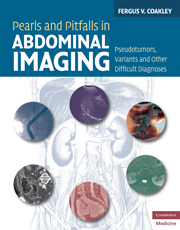Book contents
- Frontmatter
- Contents
- Preface
- Acknowledgements
- Section 1 Diaphragm and adjacent structures
- Section 2 Liver
- Section 3 Biliary system
- Section 4 Spleen
- Section 5 Pancreas
- Section 6 Adrenal glands
- Section 7 Kidneys
- Section 8 Retroperitoneum
- Case 49 Retrocrural pseudotumor due to the cisterna chyli
- Case 50 Pseudothrombosis of the inferior vena cava
- Case 51 Pseudoadenopathy due to venous anatomic variants
- Case 52 Pseudomass due to duodenal diverticulum
- Case 53 Segmental arterial mediolysis
- Section 9 Gastrointestinal tract
- Section 10 Peritoneal cavity
- Section 11 Ovaries
- Section 12 Uterus and vagina
- Section 13 Bladder
- Section 14 Pelvic soft tissues
- Section 15 Groin
- Section 16 Bone
- Index
- References
Case 53 - Segmental arterial mediolysis
from Section 8 - Retroperitoneum
Published online by Cambridge University Press: 05 November 2011
- Frontmatter
- Contents
- Preface
- Acknowledgements
- Section 1 Diaphragm and adjacent structures
- Section 2 Liver
- Section 3 Biliary system
- Section 4 Spleen
- Section 5 Pancreas
- Section 6 Adrenal glands
- Section 7 Kidneys
- Section 8 Retroperitoneum
- Case 49 Retrocrural pseudotumor due to the cisterna chyli
- Case 50 Pseudothrombosis of the inferior vena cava
- Case 51 Pseudoadenopathy due to venous anatomic variants
- Case 52 Pseudomass due to duodenal diverticulum
- Case 53 Segmental arterial mediolysis
- Section 9 Gastrointestinal tract
- Section 10 Peritoneal cavity
- Section 11 Ovaries
- Section 12 Uterus and vagina
- Section 13 Bladder
- Section 14 Pelvic soft tissues
- Section 15 Groin
- Section 16 Bone
- Index
- References
Summary
Imaging description
Segmental arterial mediolysis is a rare idiopathic non-arteriosclerotic non-inflammatory disease first described in 1976 characterized by spontaneous degeneration in the medial layer of the visceral branches of the abdominal aorta, leading to varying combinations of intramural hemorrhage, periadventitial fibrin deposition, aneurysm formation, and dissection [1]. The diagnosis should be considered when CT arteriography shows isolated dissection, small saccular aneurysms, or a “string of beads” appearance in the visceral branches of the abdominal aorta (Figures 53.1–53.3) [2–4].
Importance
The frequency of segmental arterial mediolysis may be underestimated because angiography is not usually performed for gastrointestinal hemorrhage or abdominal pain. The findings may be subtle and overlooked at CT, although the diagnosis may become commoner with the increasing availability of high resolution multidetector CT.
Typical clinical scenario
Segmental arterial mediolysis typically presents with gastrointestinal hemorrhage or abdominal pain in middle-aged and elderly patients, although cerebral involvement has been reported in young adults [5]. The natural history of the disease is poorly understood. Ruptured aneurysms or segmental arterial thrombosis may be treated by reconstruction with a graft or patch, while stenoses may be managed with angioplasty.
Information
- Type
- Chapter
- Information
- Pearls and Pitfalls in Abdominal ImagingPseudotumors, Variants and Other Difficult Diagnoses, pp. 180 - 183Publisher: Cambridge University PressPrint publication year: 2010
